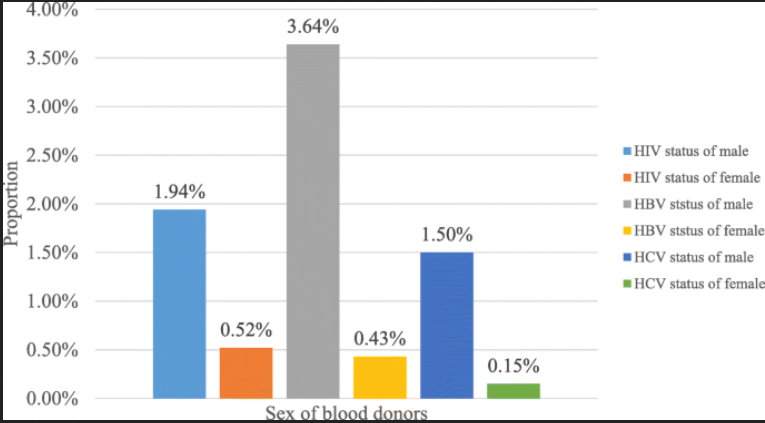Seroprevalence of Transfusion-Transmissible Infectious Agents (HIV, HBV, HCV, Syphilis, and Malaria) in Voluntary Blood Donors in a Tertiary Care Center in Ghaziabad (U.P.)
Main Article Content
Abstract
Background: Voluntary blood donation is undoubtedly, the highest form of humanitarian service as it is done without expectation of even knowing who it will help. One single blood donation actually helps many patients as blood is usually segregated into red blood cells (RBCs), Platelets, white blood cells (WBCs) and Plasma and given accordingly for their requirement.
Aim and Objective: Seroprevalence of transfusion-transmissible infectious agent (HIV, HBV, HCV, syphilis, and malaria) among voluntary blood donors in a tertiary care facility in Ghaziabad (U.P.)
Methodology: The current study was carried out from June 2018 to May 2020 at the blood bank connected to Santosh Medical College & Hospital, in Ghaziabad, Uttar Pradesh. Clear serum was prepared by centrifuging blood taken from the collection bag's tubing into a labelled tube. The samples were then tested for Syphilis, Malaria, HIV, HBV, and HCV as these all are blood borne infections that can spread by blood transfusions.
Result: All blood donors were screened for five transmissible infections viz HIV, HBV, HCV, Malaria and Syphilis. Out of all voluntary blood donors 5 cases were seropositive cases, of which 2 were positive for HBV, 1 for HCV, 2 for Syphilis infection.
Conclusion: For a safe blood service in our country, where comprehensive laboratory tests are neither possible nor pragmatic, it is best to switch over to 100% voluntary donations, as it is now established that only voluntary non-remunerated regular donation is the safest. Thus, one of our key strategies to enhance blood safety is to focus on motivating non-remunerated blood donors and phasing out even replacement donors.
Article Details
References
Srikrishn A, Sitalaxmi S, Damodhar P. How safe are our safe blood donors? Indian J Pathol Microbial. 1999; 42: 411-416.
NACO. Standards for blood banks and blood transfusion services. 2007; 33-34
Makroo RN. Historical Overview of transfusion medicine. Textbook of Compendium of Transfusion Medicine. 2010; p1-5.
Bihl F, Castelli D, Marincola F, Dodd RY. Transfusion transmitted infections. J Trans Med. 2007; 5: 25-26.
Park K et al. Epidemiology of Communicable diseases. In:Parks textbooks of preventive and social medicine 14thedt. Jabalpur M/s BanarasidasBhanot 2007:p 285-296.
Suryakant AH et al. HIV/AIDS chapter 24.In: Community medicine (with recent advances) in 1stedt.Jaypee Brothers Medical Publishers (P) Ltd. New Delhi 2009; p 439-454.
HIV/AIDS historical time line 2000-2007 (cited 2008 July;14 pages)
Godbole S, Mehendale S. HIV/AIDS epidemic in India, risk factors, risk behaviours and strategy for prevention and control. Indian J Med Res. 2005;121:356-368.
Maldarelli F. Diagnosis of HIV. In:Mandell GL, Bennett JE, Dolin R, edt. Priciples and practices of infectious diseases. 6thedn, Philadelphia Elsevier Churchil Livingstone 2005; 2:1506-26.
HIV testing manual-Laboratory diagnosis, Biosafety and quality control. National AIDS Control Organisation New Delhi.
Pallavi P, Ganesh CK, Jayshree K et al. Seroprevalence and trends in transfusion transmitted infections among blood donors in a university hospital blood bank: a 5-year study. Indian J Hematol Blood Transfus. 2011;27:1-6
Meena S, Maheshwari V, Gupta D.Seroprevalence and trends of transfusion transmissible infections among voluntary and replacement donors- an institutional retrospective study. Tropical J Path Micro 2018;4(4):330-335.
National AIDS Control Organization (NACO). Voluntary Blood donation programme- An operational guideline. Ministry of Health and Family Welfare, New Delhi. 2007:13.
Chandra T, Rizvi S, Nishant Fatima, Agarwal Devisha. Decreasing Prevalence of Transfusion Transmitted Infection in Indian Scenario. The Scientific World Journal. 2014; 2014:1-4.

